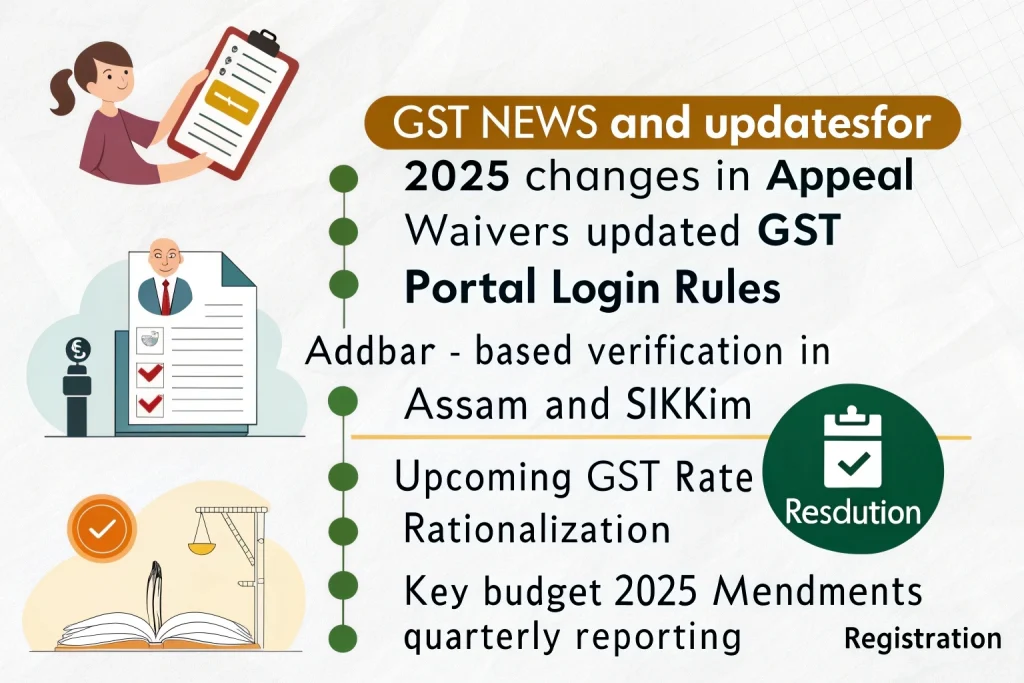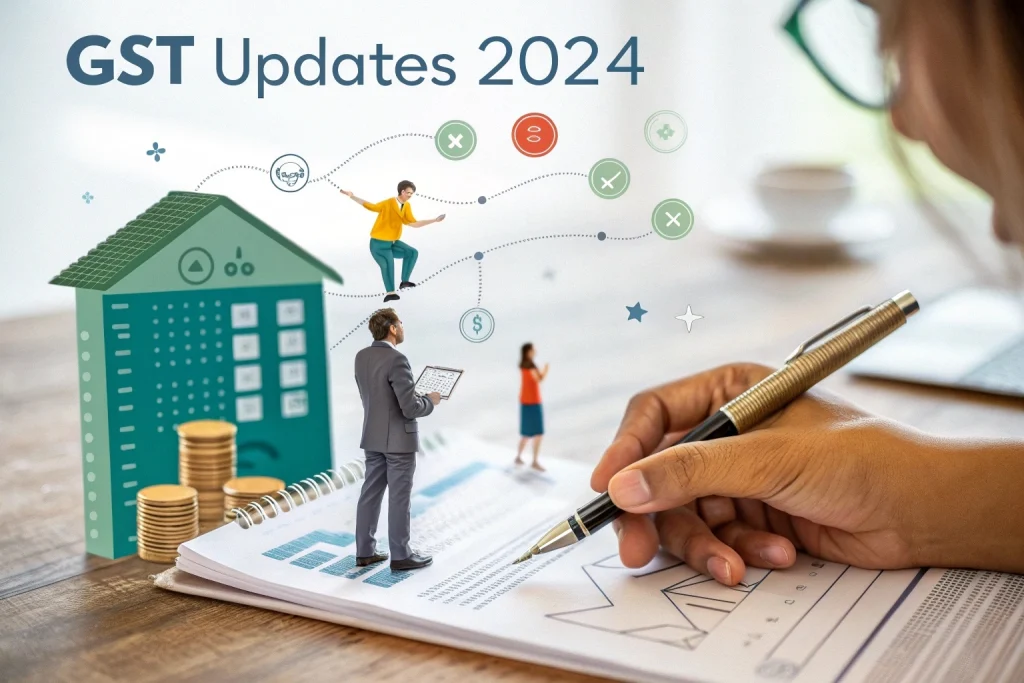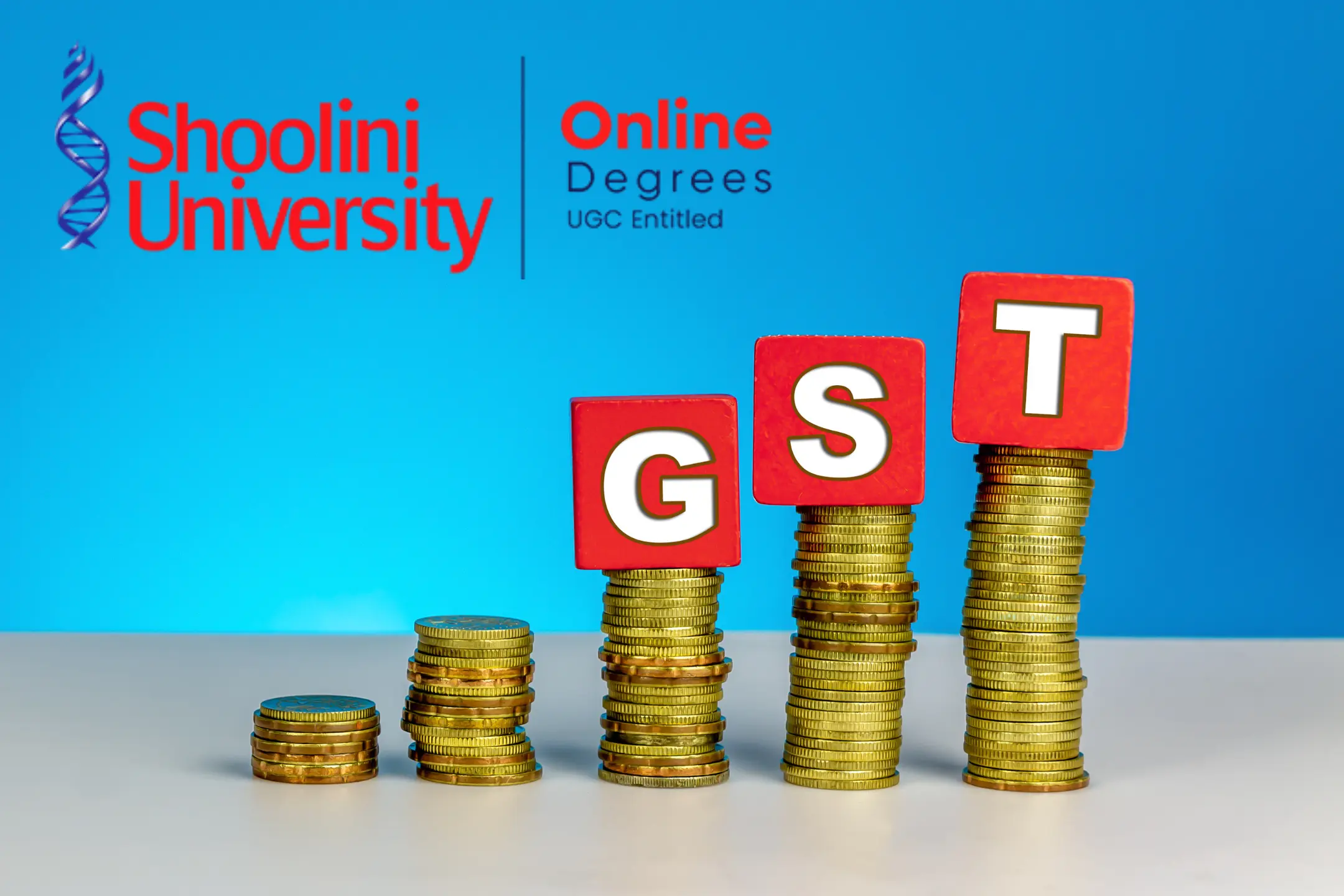Goods and Services Tax (GST) is a single tax we pay when we buy most things, like clothes or books. Instead of having many different taxes added one after another, GST brings them all together into one, making buying and selling simpler. The money collected from GST helps pay for public services such as schools, roads, hospitals, and parks.
Because GST rules and rates can change from time to time, especially with new amendment in GST introduced by the government, it’s important for businesses and individuals to keep up with the latest updates. Using the correct GST rate means you pay exactly what you owe—no more and no less—and helps you avoid fines or legal trouble that can happen if you follow an old tax rule by mistake.
Latest GST News – New amendment in GST

Key Changes in Appeals and Waivers
The GST system now lets taxpayers get rid of extra charges—like interest or late fees—if they withdraw an appeal against a tax demand. To do this, you simply take a screenshot of your “appeal withdrawal” on the GST website and upload it. If you do this before June 30, 2025, you can qualify for the waiver without waiting for official paperwork to come through
GST Portal Updates and Filing Tips
- Stronger Login Security: From April 1, 2025, everyone filing GST needs to use multi-factor authentication (MFA). This means after typing your password, you’ll also enter a one-time code sent to your phone or email.
- Quick Filing Checklist:
- Keep your invoices ready.
- File before the due date to avoid penalties.
- Use the “save draft” option on the portal so you don’t lose your work if you get interrupted.
Aadhaar Authentication and Biometric Verification
Some states now ask new GST applicants to prove their identity with Aadhaar:
- Assam: From April 1, 2025, selected applicants must visit a GST Suvidha Kendra with their fingerprint or iris scan.
- Sikkim: Since May 1, 2025, applicants receive a link after they register and choose either OTP-based or biometric (fingerprint/iris) verification.
Expected GST Rate Rationalization
The GST Council is planning to meet soon to make tax rates simpler. They may merge similar rate slabs—for example, bring a 12% and 18% slab closer together—so businesses and buyers don’t have to remember too many numbers.
Budget 2025 Highlights – GST Amendments
In the 2025 budget, the government made these easy-to-note changes:
- Quarterly Reporting: Big taxpayers will now file some returns every three months instead of monthly.
- Input Service Distributor (ISD) Rule: More businesses must register as ISDs so they can share tax credits across branches.
- Dispute Resolution: Faster time limits for resolving GST disagreements.
You can also Explore what are the GST on Goods and Services!
Major GST Updates – 2024

55th GST Council Meeting – Highlights
- The 55th GST Council met on December 21, 2024 in Jaisalmer.
- They decided to cut the tax on Fortified Rice Kernel to 5% to make food more affordable.
- They fully exempted gene therapy from GST so patients pay no tax on life-saving treatments.
- They also exempted certain insurance contributions for motor accident funds.
E-way Bills, E-Invoicing & MFA Updates
- From January 1, 2025, goods moved using an e-way bill must have documents dated on or after July 5, 2024 to be valid. Older invoices won’t work.
- Two-factor authentication (MFA) became mandatory: big businesses needed it from January 1, 2025, mid-sized ones from February 1, 2025, and all others by April 1, 2025. This means you log in with a password plus a one-time code.
Rule Changes and Biometric Registrations
- A new rule lets you do your GST registration biometric check (fingerprint or iris) in your home state even if you register in another state.
- This makes it easier: you don’t have to travel far just to scan your fingerprint.
Clarifications on ITC Mismatches and Filing Issues
- The tax department issued advice on how to fix Input Tax Credit (ITC) mismatches in the annual return (GSTR-9) for 2023-24.
- They explained which tables to use and what to do if numbers don’t match, helping businesses avoid mistakes.
Key Rate Changes and Expectations
- From October 10, 2024, several tax rates were tweaked: some goods moved to lower slabs, and a few new exemptions were added.
- For example, certain essential items became cheaper by moving from 12% to 5% GST.
- Experts expect the Council to keep simplifying slabs so everyone remembers fewer numbers.
Yearly GST Roundups
2023 GST Changes and Council Decisions
- Simpler Filing: More businesses could use one form instead of many, making it quicker.
- New Rate Slabs: A few items moved to new tax rates—some went down to help people save money.
- Late Fee Waiver: If you paid small late fees on time, the government said “it’s okay, we’ll forgive them.”
2022 GST Highlights and Reforms
- E-Invoicing Expanded: Bigger companies had to send invoices straight into the GST system, so records stayed correct.
- Digital Bookkeeping: Many businesses started keeping their accounts online, which meant fewer mistakes.
- Input Credit Clarity: Clear steps were given on how to claim back the GST you paid on things you bought for your business.
2021 GST Council Decisions
- Threshold Raised for Small Traders: Very small shops didn’t have to register for GST until they sold more each year.
- Composition Scheme Changes: Small businesses could pay a simple flat tax instead of the regular rates.
- Late Filing Relief: Due dates for returns were extended a few times to help during the pandemic.
2020 GST Adjustments Due to COVID-19
- Extended Deadlines: All businesses got extra time to file returns and pay taxes when lockdowns began.
- Reduced Late Fees: The government lowered or removed penalties for late filings to ease money troubles.
- Special Refunds: Exporters and some service providers got faster refunds to keep cash moving.
2019–2018 Key Notifications and Rate Cuts
- GST Rollout (July 1, 2017 – included here for context): India moved to one big tax replacing many smaller ones.
- Initial Rate Slabs: Goods and services were put into 5%, 12%, 18%, and 28% slabs so everyone knew what to expect.
- Early Rate Cuts: In late 2018 and throughout 2019, the Council cut GST on items like electric vehicles and everyday essentials to make them cheaper.
Important Compliance & Return Filing Deadlines
GSTR-1, 3B, 7, 9, 9C – Latest Due Dates
- GSTR-1 (Sales Invoices)
- You send a list of all your sales each month.
- Due by the 11th day of the next month.
- You send a list of all your sales each month.
- GSTR-3B (Tax Summary)
- You tell how much GST you collected and paid.
- Due by the 20th day of the next month.
- You tell how much GST you collected and paid.
- GSTR-7 (TDS Details)
- If you are a tax-deducting person, you report TDS every month.
- Due by the 10th day of the next month.
- If you are a tax-deducting person, you report TDS every month.
- GSTR-9 (Annual Return)
- You summarize all your monthly and quarterly returns for the year.
- Due by December 31 following the end of the financial year.
- You summarize all your monthly and quarterly returns for the year.
- GSTR-9C (Reconciliation Statement)
- Big businesses compare their books with what they told GST.
- Also due by December 31 after the year ends.
- Big businesses compare their books with what they told GST.
Category-wise Filing Dates (QRMP, Turnover-based, etc.)
- QRMP Scheme (Quarterly Filing)
- For small taxpayers with annual sales below ₹5 crore.
- You file GSTR-1 and GSTR-3B every three months instead of monthly.
- For small taxpayers with annual sales below ₹5 crore.
- Monthly Filing
- For taxpayers with sales above ₹5 crore.
- You file GSTR-1 by the 11th and GSTR-3B by the 20th each month.
- For taxpayers with sales above ₹5 crore.
- Special Categories
- Some people (like e-commerce operators) have their own filing rules and dates.
- Some people (like e-commerce operators) have their own filing rules and dates.
E-invoicing and E-way Bill Changes
- E-invoicing
- Big businesses (turnover above ₹20 crore) must create a special GST invoice online before billing their buyers.
- This makes sure the GST system knows about the sale right away.
- Big businesses (turnover above ₹20 crore) must create a special GST invoice online before billing their buyers.
- E-way Bill
- If goods you transport are worth more than ₹50 000, you generate an e-way bill before moving them.
- This helps check that all goods on the road have proper GST paperwork.
- If goods you transport are worth more than ₹50 000, you generate an e-way bill before moving them.
Keeping track of these deadlines is like remembering homework due dates at school—missing them can lead to small fines or reminders, so it’s best to file on time!
GST Council Meetings: Timeline & Decisions
The GST Council meets regularly—usually several times each year—to talk about tax rules. Here’s a simple year-by-year view:
- 2018: After GST began in 2017, the Council met many times to set the first tax rates and fix early problems.
- 2019: They met often to cut taxes on things like electric vehicles and everyday goods.
- 2020: Fewer meetings because of COVID-19; most talks were about giving relief and extending deadlines.
- 2021: Meetings focused on helping small shops, raising the turnover limit for GST registration, and extending due dates.
- 2022: They talked about rolling out e-invoicing to more businesses and making online filing easier.
- 2023: The Council worked on simpler forms, rate tweaks, and waiving small late fees to help everyone.
- 2024: In meetings like the 55th one, they adjusted health-care rates, exempted gene therapies, and made appeals simpler.
- 2025: So far, they’ve discussed rate simplification (bringing slabs closer) and further easing of filing rules.
Key Policy Announcements
Over these years, the Council has made several big, child-friendly changes:
- Single Tax Rates: Decided on simple slabs (5%, 12%, 18%, 28%) so shopping isn’t confusing.
- Rate Cuts: Lowered tax on essentials (like food items) and new technologies (like electric cars).
- Late-Fee Waivers: Forgave small penalties if businesses paid or corrected returns quickly.
- E-Invoicing & E-Way Bills: Required big sellers to send invoices and transport papers online to stop mistakes.
- QRMP Scheme: Let small taxpayers file returns every three months instead of monthly.
- Aadhaar & Biometrics: Asked some new taxpayers to prove who they are with fingerprint or iris scans.
- Appeals Simplified: Allowed quicker withdrawal of appeals to drop extra charges when taxpayers agree with a decision.
- Quarterly Reporting for Big Taxpayers: Let large companies file some returns once every three months to cut work.
These announcements help keep the GST system clear, fair, and easier for everyone to use—just like changing school rules to make homework simpler to understand!
Explore our online programs to become future-ready
Transform your career with industry-aligned courses designed by experts.
Rate Revisions and Rationalizations
Highest GST Rate Items
- Some things are taxed at the highest GST rate (usually 28%).
- These are “luxury” or non-essential items, for example:
- Luxury cars
- Aerated (fizzy) drinks
- Tobacco products
- Luxury cars
Goods with Zero or Reduced Rates
- Zero-rated goods mean we pay 0% GST. Examples:
- Fresh fruits and vegetables
- Grains like rice and wheat
- Fresh fruits and vegetables
- Reduced rates mean a small GST (like 5% or 12%). Examples:
- Milk and eggs (5%)
- Life-saving medicines (usually 5% or less)
- Milk and eggs (5%)
Upcoming Changes in GST Slabs
- The GST Council often looks to merge or simplify slabs so we remember fewer numbers.
- Soon, they may:
- Combine the 12% and 18% slabs into one middle rate.
- Adjust other slabs slightly up or down based on what people buy most.
- Combine the 12% and 18% slabs into one middle rate.
By revising rates and organizing slabs, the GST system becomes easier for everyone to understand—just like making game rules simpler so all players know how to play!
GST and Compliance Tools
Use of Invoice Management System (IMS)
An Invoice Management System (IMS) is like a digital notebook for all your bills.
- Keeps things tidy: It stores every invoice (a paper that shows what you sold) in one place on the computer.
- Speeds up work: Instead of writing each invoice by hand, the system fills in details for you.
- Fewer mistakes: It warns you if you forgot to add GST or entered the wrong number.
Aadhaar-Based Verification
Aadhaar-based verification uses your unique ID to prove who you are.
- Your digital ID: Aadhaar is a number linked to your name, photo, and fingerprint or eye scan.
- Safe sign-up: When someone new registers for GST, they can show their Aadhaar.
- Stops fakes: It makes sure only real people or businesses get a GST number.
ITC Matching and Auto-Population
ITC stands for Input Tax Credit—the GST you paid when you bought something for your business. Matching and auto-population help you claim it correctly:
- Auto-population: The GST system pulls in the invoices your sellers uploaded so you don’t have to type them yourself.
- Matching: It checks that what you claim (what you paid) matches what your seller reported (what they collected).
- Fixes errors: If numbers don’t match, the system flags them so you can correct mistakes before filing.
These tools help businesses manage GST like having smart helpers, making the process faster, safer, and more accurate—just like using a calculator instead of doing big sums by hand!
Conclusion
In summary, GST brings together many taxes into one simple system that helps our country grow by funding essential services. By staying updated on rates, deadlines, and new tools—like e-invoicing, Aadhaar verification, and auto-population—businesses and individuals can follow the rules correctly and avoid mistakes. With regular Council meetings and rate revisions, the GST system keeps improving to be fairer and easier for everyone to use.


Leave a Reply